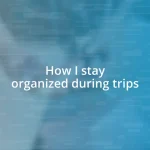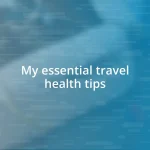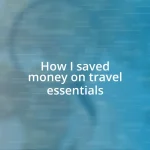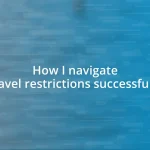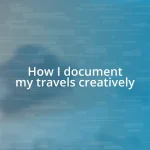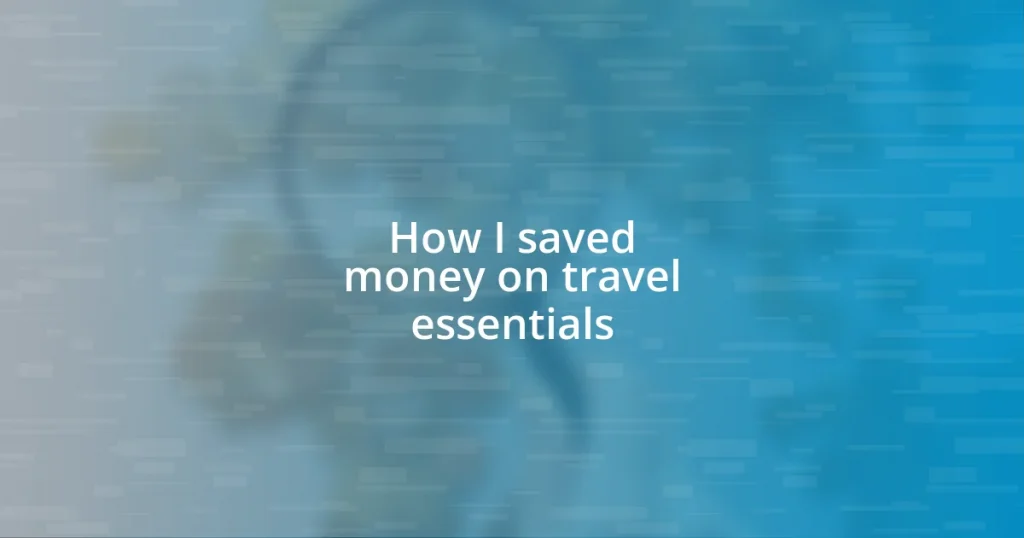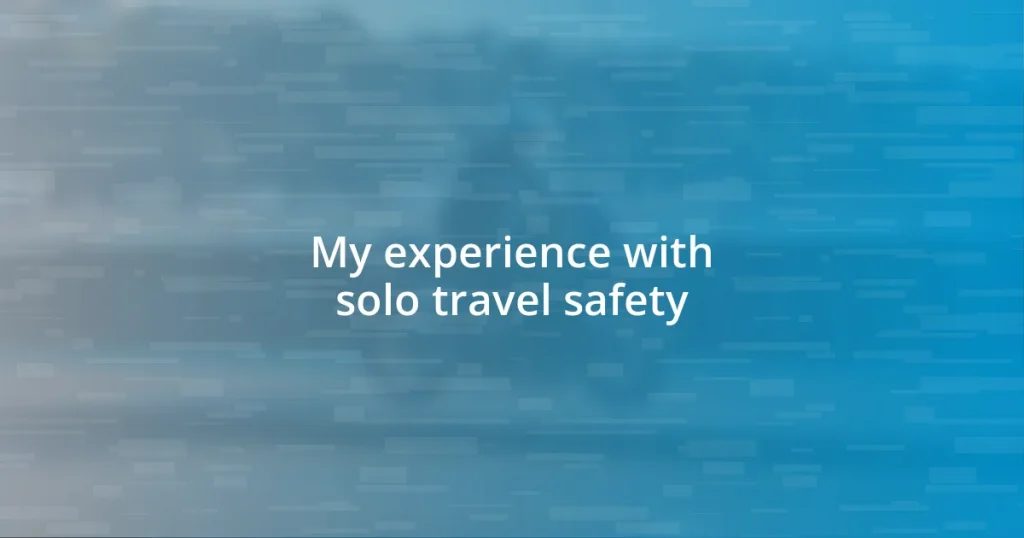Key takeaways:
- Curate a smart packing list focused on essentials to enhance travel efficiency and comfort.
- Set a detailed budget categorizing expenses to prioritize experiences and allow flexibility for unexpected costs.
- Invest in quality gear and plan for emergencies to ensure a stress-free travel experience.
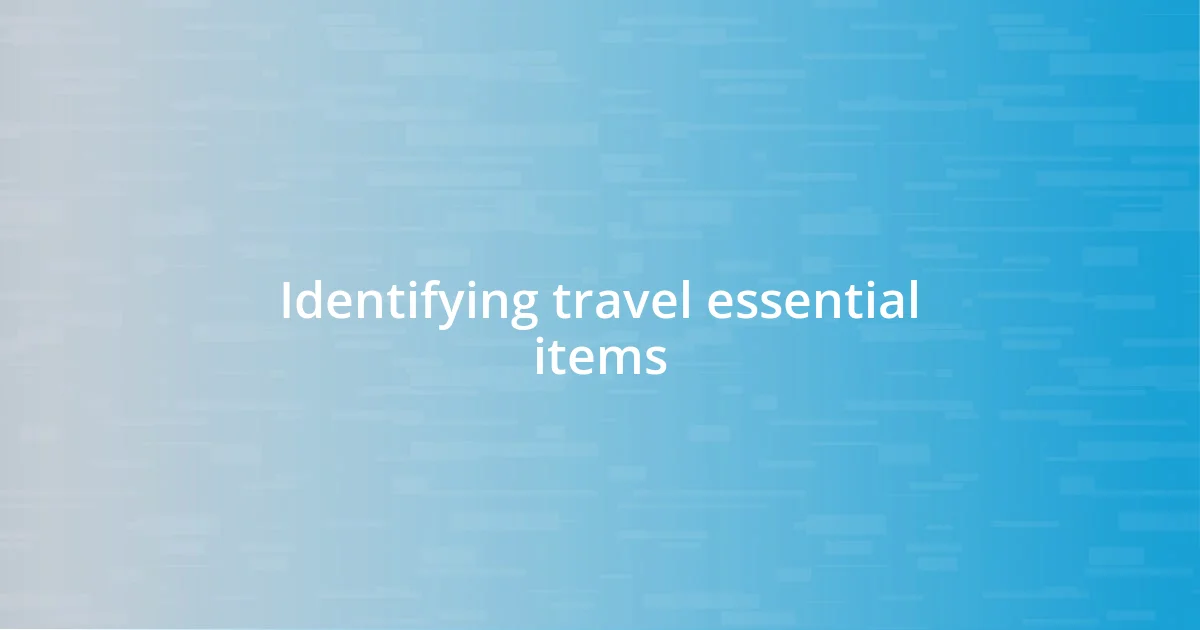
Identifying travel essential items
When I think about travel essentials, I often recall my first big trip abroad. I learned the hard way that it’s not just about packing a suitcase—it’s about packing smart. Have you ever found yourself at the airport fumbling through your bag, looking for that one item you thought you’d packed?
I realized that a well-curated list of essentials can save not just space but also sanity. For example, a compact travel pouch for documents can mean the difference between a smooth check-in and a stressful race against time. Organizing items like travel-sized toiletries and versatile clothing reduces the hassle and helps me feel ready to take on new adventures.
Another important aspect I’ve discovered is the value of prioritization. What do I really need versus what might just be nice to have? Reflecting on past trips, I’ve found that a good pair of walking shoes and a refillable water bottle are non-negotiables for comfort and hydration. How about you? What items do you always find yourself wishing you had brought along?
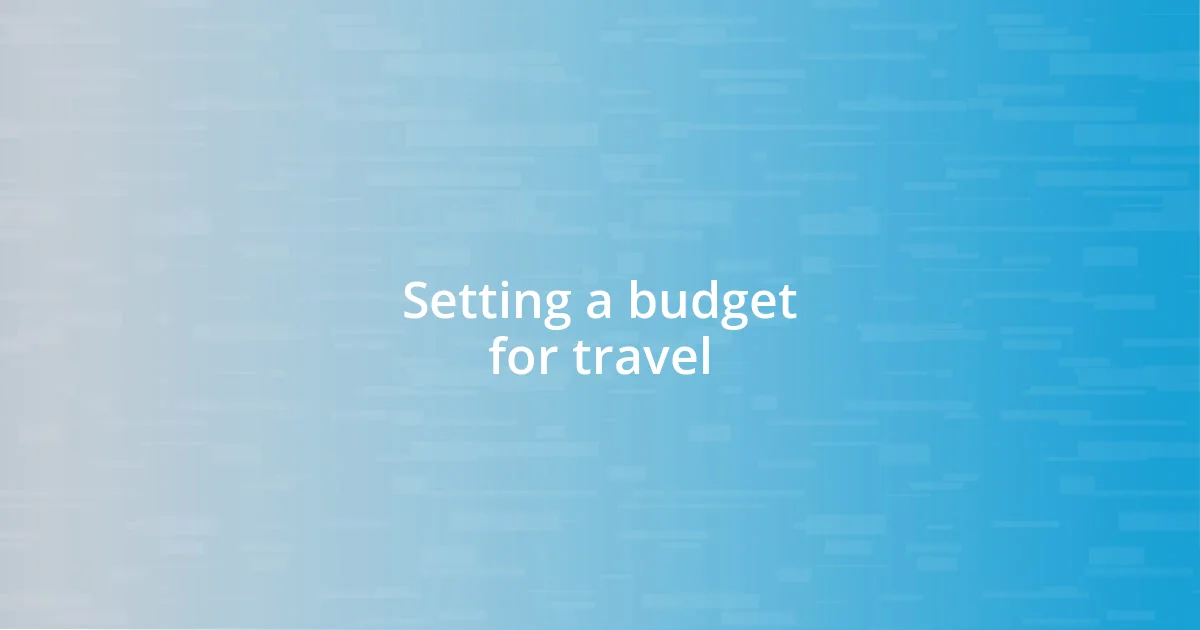
Setting a budget for travel
Setting a budget for travel is a crucial step in ensuring that your trip doesn’t break the bank. I remember my first solo trip, where I underestimated the costs of meals and transportation. I ended up spending more than I had planned, which left me feeling anxious about my spending for the rest of the journey. Budgeting isn’t just about restricting what you can spend; it’s about feeling empowered and prepared for what’s ahead.
When I plan a trip, I like to categorize my expected expenses: accommodation, food, transportation, and activities. This method not only helps to clarify where my money goes but also allows me to prioritize experiences that matter most to me. For instance, I once splurged on a once-in-a-lifetime experience, a hot air balloon ride, but compensated by choosing budget-friendly hostels. Have you ever thought about how embracing a flexible mindset can lead to both savings and unforgettable moments?
Creating a budget allows for some wiggle room for unexpected expenses, like those delightful food stalls you stumble upon. I learned that including a small buffer in my budget makes me feel more relaxed and open to spontaneity. After all, those unplanned adventures often become the highlights of our travels, and knowing I have funds set aside lets me seize those moments without hesitation.
| Category | Estimated Cost |
|---|---|
| Accommodation | $50 – $150 per night |
| Food | $30 – $70 per day |
| Transportation | $15 – $50 per day |
| Activities | $20 – $100 per activity |

Comparing prices and deals
Comparing prices and deals is an essential step in making travel more affordable. I often find myself scrolling through various websites, each offering different prices for similar items. It can be overwhelming at times, but I’ve learned that a little patience can lead to significant savings. For instance, when I was planning a recent trip, I noticed that a single travel adapter was available for as low as $10 on one site and as high as $25 on another. Taking the time to compare options allowed me to snag the best deal without compromising on quality.
Here are some tips to keep in mind when comparing prices:
- Use multiple platforms: Don’t rely on just one website; explore various travel sites and compare the same item across them.
- Sign up for alerts: Some websites offer price drop alerts, which can notify you when an item you’re interested in drops in price.
- Check for package deals: Sometimes, bundling items—like travel insurance with your flight—can lead to substantial discounts.
- Read reviews: A lower price might not always be the best option. Checking reviews can help ensure you’re getting a good deal on a quality product.
- Consider second-hand: Platforms like eBay or Facebook Marketplace can yield great finds on barely used travel essentials.
Investing a little time in this process has not only saved me money but also given me a sense of satisfaction every time I find a gem at a discounted price. You’d be amazed at how rewarding it feels to outsmart the system!
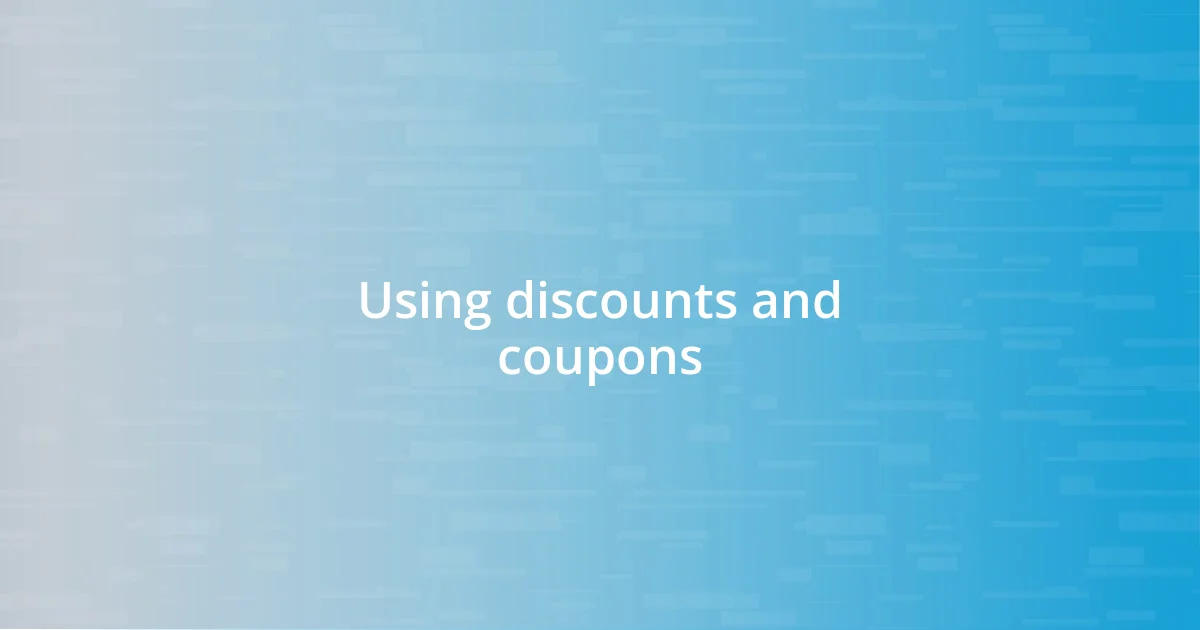
Using discounts and coupons
I’ve always been on the lookout for discounts and coupons when preparing for a trip. There was one instance when I discovered a fantastic coupon for a popular travel gear retailer just a week before I was set to leave. It knocked 30% off my total purchase! I felt that rush of excitement—who doesn’t love a good deal? It was a small triumph that set the right tone for my adventure, and that one little coupon ended up saving me over $50 on essentials.
Signing up for newsletters can be another goldmine. I remember doing this before my recent trip to Japan. The store sent me a surprise email with a buy-one-get-one-half-off deal. That prompted me to buy an extra set of packing cubes, which I had been mulling over for ages. Just think about it: small investments like that not only keep your luggage organized but can also streamline your travel experience. Have you ever wondered how much easier your journeys could be with a little organization?
Using apps dedicated to finding coupons can be a game-changer, as I learned when I stumbled upon one for my travel-sized toiletries. I was able to score some high-quality products at a fraction of the regular price. The sense of accomplishment I felt from being a savvy shopper translated into more money for experiences during my trip. You don’t realize how much these small savings add up until you’re standing in front of a beautiful sunset, knowing you had the foresight to turn those discounts into unforgettable memories.

Timing your purchases wisely
Timing your purchases can significantly enhance your savings on travel essentials. I’ve noticed that shopping during sales seasons, like after the holidays or right before summer, can yield amazing deals. Last year, I bought travel pillows for a trip at nearly half off just because I planned my purchase around a seasonal sale. Have you ever thought about how a little foresight can lead you to snag great items at unbeatable prices?
Another tactic I’ve found effective is keeping an eye on when new stock arrives at stores. Retailers often want to clear out older inventory to make space for new products, resulting in discounts. I remember walking into a travel supply store just as they were transitioning seasonal gear. I spotted high-quality luggage sets marked down significantly, and I caught myself smiling, knowing I’d saved a bundle while preparing for my next adventure. It’s worth checking in regularly; you never know when a perfect opportunity might pop up.
Timing also extends to booking your travel essentials. I typically aim to make purchases about six weeks before a big trip. This timeline allows me to take advantage of early-bird sales while still having time to compare prices. There’s something rewarding about seeing how strategic decisions can lead to enjoyable experiences without breaking the bank. Do you plan your purchases, or do you wait until the last minute? I’ve learned that a bit of planning can turn the excitement of travel preparation into a rewarding journey in itself.

Choosing quality over quantity
Investing in quality gear can truly transform your travel experience, and I’ve seen this firsthand. On a recent trip, I decided to splurge a little on a durable carry-on instead of picking the cheapest option. The sturdy zippers and well-designed compartments made navigating airports so much easier. Have you ever noticed how the right equipment can lift the stress off your shoulders? It’s not just about saving money upfront; it’s about choosing items that will endure the rigors of travel and serve you well over time.
When I bought a pair of high-quality noise-canceling headphones for a long-haul flight, I felt a surge of guilt at the price tag. However, the moment I sank into my seat and tuned out the chaotic hum of the airport, I knew I had made the right choice. The comfort they provided allowed me to relax and even enjoy a movie without distractions. I often ask myself, wouldn’t it be worth spending a bit more on quality items that enhance your comfort and enjoyment? Sometimes, it costs a little more, but that return on investment is priceless.
Quality items often come with warranties or guarantees, which is something I’ve learned to value over the years. Recently, I purchased a rugged travel backpack that promised a lifetime guarantee. Knowing I could rely on this product for years to come not only reassured me during my travels, but it also made me feel confident in my investment. Have you ever considered how much peace of mind a quality item can provide? It’s more than just a purchase; it’s a commitment to enjoying your travels without the hassle of frequent replacements.
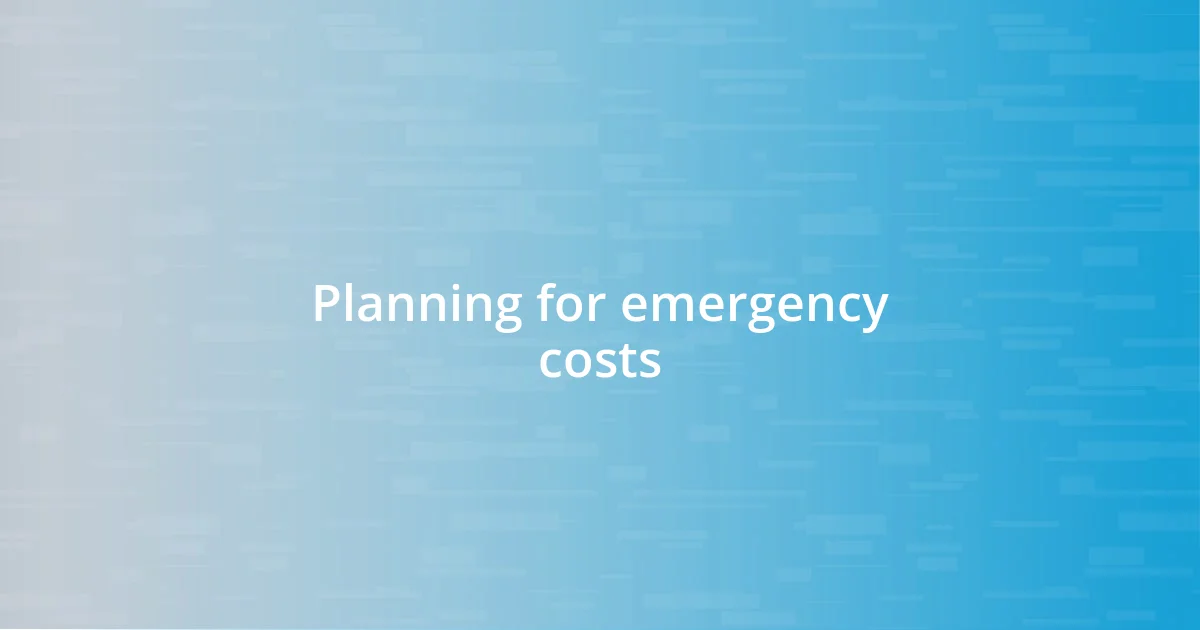
Planning for emergency costs
Planning for unexpected expenses is something that can often slip our minds during exciting travel preparations. I remember my first big trip, when I gleefully packed my bags without considering emergency costs. Halfway through the journey, a small mishap led to a hefty medical bill that threw my budget into disarray. Have you ever faced similar surprises? It’s a lesson I certainly won’t forget: setting aside a designated fund for these unforeseen costs is crucial.
I like to have a buffer fund, usually around 10-15% of my total travel budget, reserved for emergencies. This strategy provides peace of mind, knowing that I can handle sudden expenses without derailing my entire trip. Last summer, while hiking, I sprained my ankle and had to visit a local clinic. Thankfully, my emergency fund covered that visit, allowing me to focus on my recovery rather than my dwindling budget. Isn’t it comforting to know you have a safety net?
In addition to a buffer fund, I also consider travel insurance. While it might feel like an added expense, I’ve found it invaluable. On a recent trip abroad, my flight got canceled and I had to book a last-minute hotel. Because I had insurance, I was reimbursed for those costs. Isn’t it reassuring to think that a little extra planning can shield you from financial uncertainty? Taking steps to prepare for emergency costs can transform travel from an anxious journey into a more enjoyable and stress-free experience.



